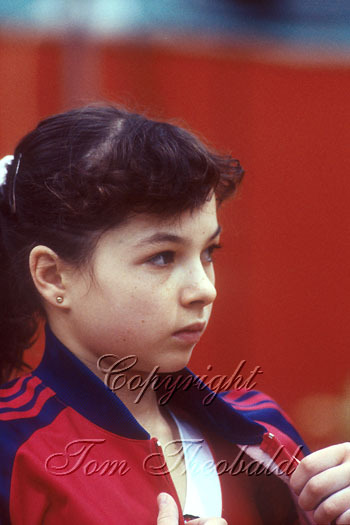#olga bicherova
Photo

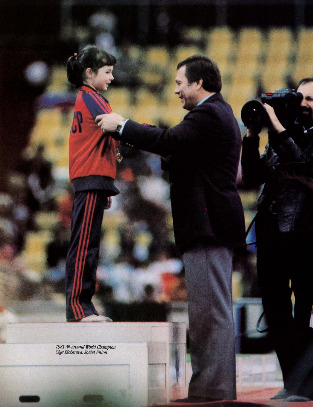


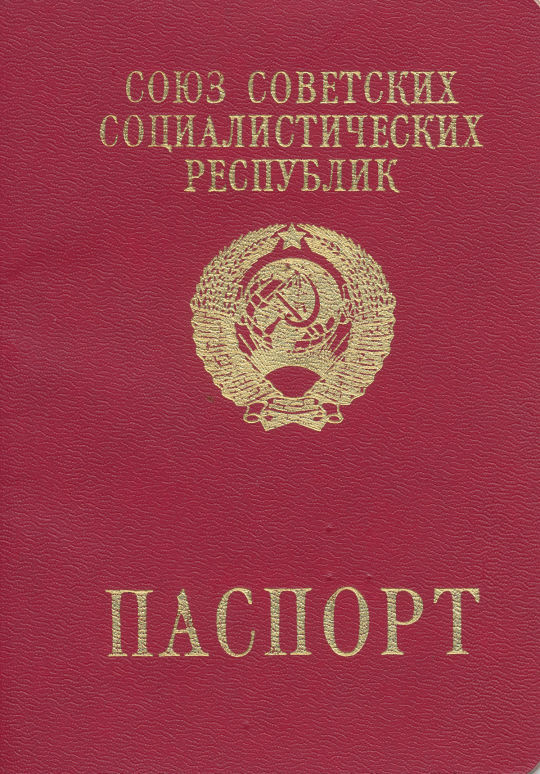




A non-exhaustive list of gymnasts whose ages are known to be falsified.
“Dick does she look 14 years old to you? [...] I tell you we have a story going around the gymnastics community that is pretty traditional that when a young Romanian girl is asked her age she looks to her coach for the answer.” --Bart Conner, 1985 American Cup
Since Wikipedia can’t be trusted to be right for a lot of details of gymnasts careers...
Olga Bicherova
Born in either 1967 or 1968, during Bicherova’s elite career the age requirement was that you had to turn 15 in the year of competition. Either birthdate would have made her too young for the 1981 World Championships where she won two gold medals, one in the all around and one with the team. If you take the 1967 birthdate she could have been age eligible for the 1982 World Cup where she won 5 medals, 3 of them gold except that one of the requirements of the World Cup at that time was previous participation in the World Championships. [In fairness to Bicherova the above picture is slightly mean of me to use as she never grew very tall.]
Ecaterina Szabo
Born in 1968, during Szabo’s elite career the age requirement was to turn 15 in the year of competition meaning her first year of senior eligibility should have been 1983 and 1983 is when her first major titles occurred. Except she was competing as a senior in 1982 winning a number of international invitationals (which she may have been eligible for anyway because juniors and seniors often competed together at those). It’s unclear to me why her birthdate was changed though it might have simply been something that happened when the government changed her name to hide her Hungarian ethnicity. Szabo’s first language is Hungarian and she was born in Transylvania as Szabó Katalin. She still goes by Katalin in her private life. She was of age during the 1984 Olympic Games and the 1983 World Championships
Olga Mostepanova
Born in 1970, during Mostepanova’s elite career the age requirement was to turn 15 in the year of competition (or 14 for the World Championship that qualified for the Olympics). She has said herself that while she was competing her passport was wrong by “years”. By the accounts as I understand them her first senior year should have been 1985. Mostepanova was the top Soviet gymnast in 1984 winning the alternative games held for countries that boycotted the 1984 Olympic Games (and the reality of her age falsification makes playing ‘What if?’ for who should have won the 1984 Olympics awkward). Aside from her 5 Friendship Games gold medals, she would have also been age ineligible for the 1983 World Championships where she won 4 medals, 2 gold (team and beam) and 2 silver (all around and floor).
Oksana Omelianchik
Born on January 2, 1970, during Omelianchik’s elite career the age requirement was to be turn 15 in the year of competition and her first year of eligability was 1985. None of Omelianchik’s elite career honors are tainted however she says at one point she was given a passport with her birthdate shifted by a week (which would have made her able to compete in the 1984 Olympic Games).
Daniela Silivaș
Born in 1972, during Silivaș’ elite career the age requirement was that you turn 15 in the year of competition meaning her first year as a senior elite should have been 1987. In 1985 she won a European bronze medal on beam, a World Championship gold medal on beam and a silver with the team. She also won 3 medals at the 1986 World Cup. She was of age for the 1988 Olympic Games
Kim Gwang-suk
Only the universe knows what year Kim Gwang-suk was actually born. She was listed as 15 years old for three consecutive years by the North Korean government from 1989-1991, and then 17 years old at the 1992 Olympic Games. She may have been as young as 11 when she competed in the 1989 World Championships. In 1991 she won the World Championship gold on the uneven bars and at least one of her birth years means she might have been age eligible for that competition (which may be why FIG was reluctant to take away that medal, officially they decided that as she wasn’t personally involved in the fraud she could keep it). The North Korean team was banned from the 1993 World Championships for the sloppy fraud.
Alexandra Marinescu
Born in 1982, the age requirements changed in the middle of Marinescu’s elite career. For the 1996 Olympic Gams you had to turn 15 in the year of competition and starting in 1997 you had to turn 16. The Romanian state issued her a passport giving her birthdate as 1981 and it is worth noting that this was the post revolution Romanian government. She competed at 1995 Worlds, 1996 Worlds, and the 1996 Olympic Games with a stated birthdate that would make her just old enough to compete in those competitions. In fact she was younger than both Dominique Moceanu and Vanessa Atler. At no point during her entire elite career which lasted 3 years was Marinescu of age. She has 3 World medals (2 gold for the team in 1995 and 1997, 1 silver on beam from 1996), and one Olympic medal (bronze in the team from 1996). The FIG database still lists her incorrect birth year and the Romanian gymnastics federation claims that she is lying about the age falsification (as well as other abuses she has been outspoken about).
Dong Fangxiao
Born sometime in January of 1986 (the exact day is still disputed), during Dong’s elite career the age requirement was to turn 16 in the year of competition. Her first year of senior competition should have been 2001 but she competed at the 1999 World Championships under the rule at the time that if you are eligible for the Olympic Games you cold compete at the World Championships the previous year. She won a bronze medal at both 1999 Worlds and the 2000 Olympics with the team. In 2008 she applied to be a technical official at the Beijing Olympic Games she listed her true birthdate instead of the 1983 birthday under which she had competed. An investigation of the case resulted in both medals being stripped.
Hong Su-jong
At different competitions during her career Hong Su-jong was entered with a birth year of 1985, 1986, and 1989. At some of these competitions she was entered with a different birth year as her twin sister Hong Un-jong (Olympic and World Champion who has never herself been implicated in age falsification). Hong Su-jong’s most significant medal was the 2007 World silver on vault which she is believed to be of age for but she competed at the 2004 Olympic Games with the 1985 birthdate and for that competition she was too young. Hong Su-jong was eventually banned permanently from competition and North Korea was banned until October 2012 meaning that her sister was unable to defend her 2008 Olympic vault gold.
You may notice that He Kexin is not on this list...
During (and after) the 2008 Olympic Games questions were raised about two time Olympic Gold medalist He Kexin’s age (as well as that of several of her team mates). Unlike all of the above cases where either inconsistent age information was entered at official FIG competitions or the gymnast themselves have stated that their birth year was changed, He’s birthdate has always been consistent in FIG documents and she herself has always denied falsification. Her age was listed as earlier in entries for some domestic meets and that was reported by foreign press as evidence that she was too young. This ignores the fact that age falsification (in both directions up and down) was common by city and provincial teams in China to enter age bracketed competitions and that is what may have been going on. Either way these competitions are not governed by the FIG so the inconsistent birth information at them was not their problem. I am generally agnostic about He’s birth year. There is strong circumstantial evidence to suggest that her age was changed (that doesn’t have to do with domestic competition forms or her appearance) however I understand why the FIG investigation decided that there was not enough evidence for them to act.
Sooooo the only people punished for age falsification have been Asians. That’s kind of racist isn’t it?
Two things can be true at the same time. Yes it is highly suspicious that only North Korea and China have been punished for this while there are documented cases of European federations also doing this. However I think it’s important to note that these cases are not all the same. North Korea was punished for providing inconsistent birthdates for the same gymnast at competitions. The evidence of the offense was right there in FIG’s paperwork. China was punished when Dong applied to be an official with FIG giving an inconsistent birth year.
All of these other cases involve gymnasts whose paperwork was consistent during their careers.
The fact that FIG is only accepts that level of proof and unwilling to accept (especially in Marinescu’s case) the gymnasts own statements about their birth year certainly doesn’t make them look like they are particularly interested in punishing this kind of cheating unless absolutely forced to. I would offer the counter point that FIG is not the police and they do not have the ability to determine if there is something else going on with such public statements and they often came out well after the standard 10 year statute of limitation for stripping medals (except in the case of Marinescu). Some have suggested that FIG was reluctant to act on Marinescu’s statements because stripping Romania of those medals would promote China who was also age cheating at the time. I don’t think you have to go to that place when the answer is just as likely that FIG has a very narrow standard of proof for revoking medals on the basis of age falsification and has even erred on the side of allowing the gymnast (Kim Gwang-suk) to keep a medal won while clearly under age.
Are FIG officials racist against Asians? There is a lot of evidence for that.
Has FIG only punished Asian nations for age falsification? Yes. But it’s more a case that North Korea is really bad at this and the Dong case has fairly unique circumstances.
#gymnastics#olga bicherova#daniela silivas#he kexin#hong un-jong#hong su-jong#alexandra marinescu#olga mostepanova#oksana omelianchik#ecaterina szabo#kim gwang-suk
55 notes
·
View notes
Photo

“he kexin did NOTHING wrong. she was a g_ddamn child, she didn't falsify any papers, that was entirely on the chinese association. same for every other underaged gymnast (Kim Gwang Suk,Lavinia Agache,Olga Bicherova,Gina Gogean,Alexandra Marinescu,Olga Mostepanova,Daniela Silivaş,Dong Fangxiao,Hong Su Jong) they were f*cking kids that were forced into competing young by the adults in their national associations”
18 notes
·
View notes
Note
Gutsufan ha subido hace poco a su canal unos videos de la copa del mundo de zabgreb de... 1982 !! Y con comentarios en español, porque parece ser que en esa época retransmitían las pruebas de copas del mundo :) Lo dejo aquí por si a alguien le interesa, que salen maxi gnauck, natalia yurchenko, olga bicherova, etc (quería ponerlo en inglés pero no me salían las palabras, y como te he visto escribir en español alguna vez...)
Sí, soy de España! jajajajjaja. Muchas gracias! 😘
if anyone wants to watch, gutsufan YT channel uploaded videos from the 1982 World Cup (I think that’s when Yurchenko debuted the Yurchenko vault? or did she do it at worlds next year?) with spanish commentary if any of you speak spanish or want to learn it. With Yurchenko, Bicherova, Gnauck, Agache, Ilienko, Ma Yanhong, McNamara,... Good field!
Yeah... I would love if Teledeporte could broadcast at least one or two world cup events next year to promote the sport, giving that they will actually count for Olympic qualification. It’s almost infurating that back in the 80′s, with just two TV channels, there were more Spanish gymnastics broadcasts than nowadays with all the sport channels or streams we have, either public TV or cable. For example, Eurosport España covers skating GP events, they could do something similar with gymnastics. Although it’s true back then the World Cup was a major event, it was almost like individual Worlds giving that the World Cup only happened in non-Olympic even years.
0 notes
Photo

15 notes
·
View notes
Video
youtube
Soviet Olga Bicherova profile. It's in Russian but you can get the gist. Happy Birthday Olga, you wonderful thing.
0 notes
Photo
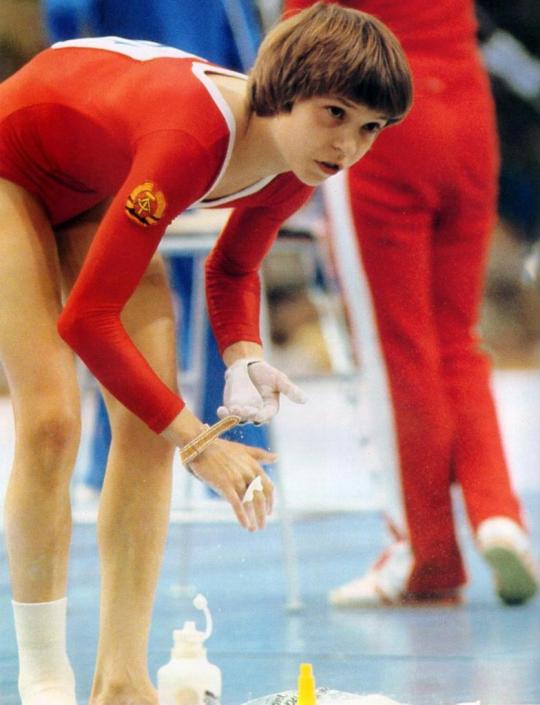
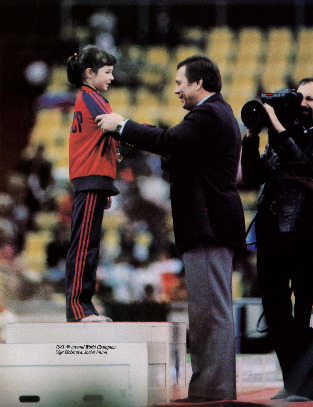
A Gymnastics Mystery: Was the 1981 World Championship Stolen? Part 1 - An Introduction
In 1981 Maxi Gnauck was the most dominant gymnast in the world when she pulled up short in the middle of her Team Optionals floor routine with an ankle injury. Leaving the floor meant that she was effectively out of the all around competition in a year when she had dominated every competition she entered. A few minutes later she would be seen sprinting down the vault runway in the back of the television shot as she continued to lead her team to medals throughout the rest of that World Championships.
With her out of the competition the Soviet Union would sweep the All Around podium at the 1981 World Championships in Moscow, with the gold going to an age falsified 12 year old Olga Bicherova. Bicherova’s true age already taints this world championship but I’d like to walk you my reader through the events of that year and see what you think. Fair warning... I can’t make up my mind if Gnauck was forced to throw the World Championship that year or if it was a true injury.
Because I’m going to show a lot of video this post will be broken up because tumblr limits how many videos you can embed in a single post and I think it’s important to actually see the competition routines.
First... let me tell you about probably the most dominant bar worker of all time... and how she was more than a bar worker.
Maxi Gnauck was born in Berlin in 1964, competing in her first international senior competitions at age 15 in 1979. At her first European championship in Copenhagen in 1979 she would take a bronze medal on the uneven bars. She would never walk away from another competition with less than a gold on bars for the rest of her career retiring in 1985. A six year senior career, still competitive at age 21 in the 1980s is itself a remarkable feat in an age when the sport was progressively being seen as the domain of younger and younger girls. A winning streak lasting that long would be remarkable in any age putting her in the ranks of legends of the sport.
But she wasn’t just a bars worker. She was a true all arounder. To save time going through her medal record to establish that this is the graphic from wikipedia...
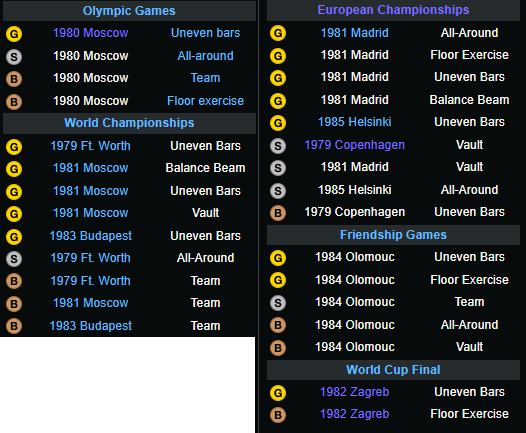
We remember her as a bars worker because that’s where her Olympic gold comes from, but she was a one who was challenging the Soviets for all around medals over a five year span coming in behind Kim, Davydova and Mostapenova. But in particular I want you to look at 1981 in that record and you can begin to understand where this mystery starts.
In my next post on this subject I’ll walk you through that 1981 season but for now I want to introduce you to the kind of gymnast Maxi Gnauck was when she stormed onto the scene in 1979. The 1979 World Championships also has a cloud over it involving if the Romanian government sabotaged their own team by faking an infection in Nadia Comăneci’s wrist forcing her to withdraw from the competition (Nadia to this day insists the infection was real). There generally isn’t a suggestion that there was any kind of deal made between the Romanians and the Soviets and the Romanians would win their first team championship in 1979 thanks to a non-hands beam routine from Nadia. Whatever conspiracy there was seems to have been within the Romanian government and national team (read Bela Karolyi).
With Nadia out the All Around was open for Soviet Nellie Kim. It’s worth remembering that during this time Kim had a reputation for being friendly and gracious. Even in the west many considered her world championship not just deserved but satisfying after she had competed in the shadow of Nadia. What no one expected was for the 1979 World Championship AA to be a fight.
Kim won that All Around by .275.
youtube
This is the ABC coverage of the 1979 World Championships AA.
In the years leading up to this Nadia had been considered athletic but doing lower difficulty, clean gymnastics. Nellie Kim was the difficulty chucker unrewarded by a code of points capped at 10. So what is Gnauck. Well, as you can see from her floor she was perhaps one of the greatest tumblers of her time. Start at 9.36 for Gnauck’s floor. And as you watch that remember... that is essentially a dead floor. 20.03 will show you her balance beam where she has a major balance check which like cost her the gold.
Most often the label put on Gnauck at the time was “elfin” and though I don’t think you would reach for balletic terms to describe her gymnastics I do want to show just how good her extension and mastery were.
youtube
Maxi Gnauck (GDR), Compulsory FX, 1980 Olympic Games
Again the controversy in 1980 would surround Romania and Nadia. There is very little argument these days that Romanian judge Maria Simionescu attempted to steal the olympic gold for Nadia after the Romanian gymnastics legend had a less than legendary beam routine. Here is a Sports Illustrated article about the incident (though be warned like most contemporary journalistic pieces dealing with Nadia it’s super weird). But when you say that Nadia was still over scored (even as she didn’t get that AA) you often overlook that she tied for the silver. With Gnauck. Bela Karolyi was too busy throwing a fit to pay attention to the gymnast who now had to share a medal with Nadia that she should have held outright. But Bela’s tantrum would focus on Gnauck a few days later in the bars final.
youtube
Maxi Gnauck (GDR), UB, 1980 Olympic Games EF
youtube
Emilia Eberle (ROM), UB, 1980 Olympic Games EF
Watching old school bars is not my favorite thing, I’ll admit, but I think even a modern viewer can understand why Bela’s screaming (literally) that Eberle should have won gold rings false. Form matters and form was what Gnauck had on bars in spades.
Gnauck’s bars are precise, relentless. She never made a mistake. She could be counted on to hit that set no matter what. And coming out of 1980 into the next season she was maturing and growing more powerful. She could only get better...
Next time: 1981 the nearly perfect year...
9 notes
·
View notes
Photo

“ Daniela Silivas, Alexandra Marinescu, Olga Mostepanova, and Olga Bicherova (among other European gymnasts) all admitted and confirmed they competed and won medals while underage with false paperwork, but somehow have never received an ounce of the derision that He Kexin has. “
15 notes
·
View notes
Video
youtube
Going old school here.
3 notes
·
View notes
Photo

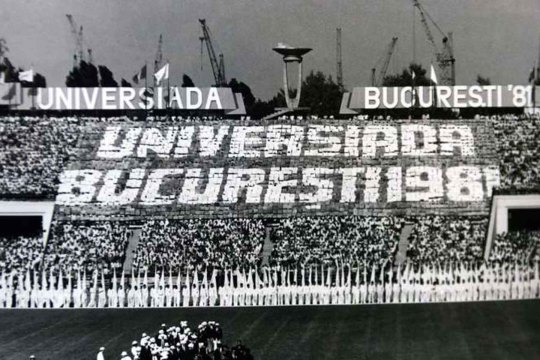
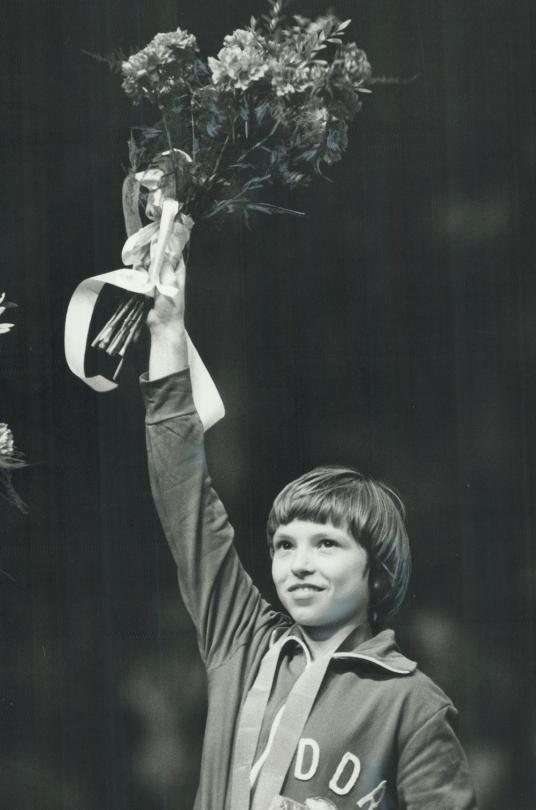
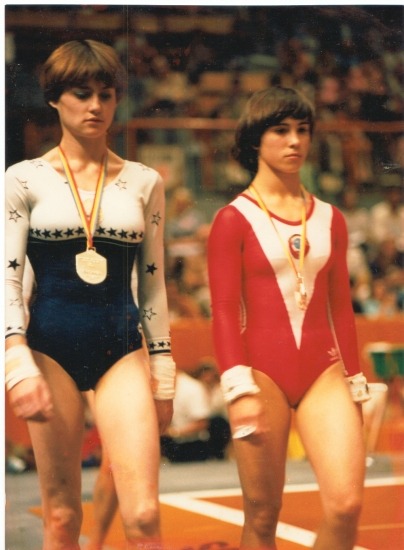
A Gymnastics Mystery: Was the 1981 World Championship Stolen? Part 3 - A Simmering Soup of Corruption
Previously, on Katherine decides to explain a 40 year old sports/political thriller... in part 1 I introduced Maxi Gnauck and the general atmosphere of corruption around the 1979 Worlds and 1980 Olympic Games and in part 2 I took you my reader through one of the most dominating performances at a major gymnastics meet ever.
Now we reach the point in this story where I get to introduce you to, without question or debate, the most rigged major international gymnastics meet ever: The 1981 University Games held in Bucharest, Romania. An increasingly irradic and prestige hungry Romanian dictatorship looked at the 1980 Moscow Olympics and craved the same experience. Except they couldn’t afford to host an Olympics so instead they secured the right to host the 1981 University Games. This is what the WAG results look like:

The gym history blog the Medal Count goes on to describe, “On the men’s side things were even worse. There are eight events in men’s gymnastics and Romania won medals on seven of them. Five of them were gold including the AA and team competitions. Unlike their counterparts in WAG, the Romanian men’s team was by no means a gymnastics power. These results were completely out of line for a program that failed to medal in every major gymnastics competition from 1980-1987.”
The display was comical, with Nadia Comăneci receiving 10s for very obviously faulty routines and many countries were angry over the blatant theft. China began to protest results they didn’t like by simply not showing up to the medal ceremonies (something that would repeat at the 1981 World Championships and today would result in a forfeit). The Soviet’s had watched this competition be stolen and the Romanian/Karolyi attempts to de-legitimatize the 1980 Olympics and it became very clear that there would be retaliation. Especially with that year’s world championship in Moscow. The Romanians decided to keep Nadia off the worlds team knowing that she would likely be humiliated. The American media, forever obsessed with Nadia, made her and the Romanians the victims, never once mentioning the broader circumstances (the American network ABC even aired a fluff piece about Nadia’s performance at the 1981 University Games as if it was a return to perfection).
The title of this extended piece is of course, a bit ironic, was the 1981 World Championship Stolen? Well, yes, because you have to begin with the 12-year-old in the room. Moscow native Olga Bicherova’s age was falsified so that she could compete and on some level that already nullifies the results of this competition. And there is the ... eyebrow raising statistic that Romanian won zero medals at 1981 Worlds. I will say watching the competition you don’t necessarily see obvious rigging. The Romanian team wasn’t at their best (after all they’d peeked for the University Games some months before) and by rights they probably should have been able to get a team bronze but performances on the day let that slip away.
That left the Soviet’s one big (or rather short) problem in reasserting their domination in front of a home crowd: Maxi Gnauck. And now we slip into broader geopolitical topics. While Romania was, in name at least, a socialist country, it’s dictatorship very actively wanted to assert independence from the USSR. The Romania-Soviet gymnastics rivalry was part of showing that it was not a puppet state. East Germany was in a very different circumstance. The relationship of the dystopian police state to their Soviet masters is complex but it can essentially be boiled down to two things: they were essentially still an occupied territory and while the Soviet use of military force to put down reform movements in Hungary and Czechoslovakia is more well known they had first done so in 1950s East Germany. The second thing to understand is that communism was not born in Russia, but arguably in Germany and so in many ways the East German state embraced socialism more fervently than any other Warsaw Pact country. If their soviet masters asked them to do something, they would. It’s one reason East German gymnastics victories were never hailed in the west the way Romanian ones were. One was the enemy of our enemy and the other was our enemies pet.
And now we reach the conspiracy theory: The Soviets asked the GDR to have Maxi pull out of the team optionals floor. That would prevent her from qualifying for the AA final and from the floor final--an event she had an Olympic medal on and which the Soviets saw as the marque event in the sport. In return they would not interfere in her other events. I don’t think there is a suggestion that she was promised the gold in those events finals, for one thing Gnauck wasn’t the leader going into the beam final and she only won that because American Julianne McNamara went over time.
But let’s look at these events as they played out.
youtube
This is the ITV broadcast of the 1981 World Championships Team Optionals. The East Germans start on beam with a relatively strong rotation. Gnauck gets a 9.8 on beam and then they move to floor. Go to timestamp 10.26 to see Gnauck’s floor, she appears to balk on her opening tumbling pass and then pulls out of the floor. There are a few explanations: The official version is that she had an ankle injury (and you know you would tumbling nearly unsprung floors and landing on hard thin mats). I’ve heard one former gymnast look at that pass and advocate that she had a real injury because she doesn’t get much of a rise. Another theory goes that Gnauck was a veteran competitor who knew as soon as she balked the pass that she was out of the AA and simply pulled off the floor to avoid an actual injury. This seems... a bit out of character to me. Gymnasts are culturally indoctrinated, especially four decades ago, to finish their routines. The broadcast focuses on the East German coaches huddling around her before moving on to show the Chinese floor rotation. But only minutes later (13.30 in the video) the commentators note in surprise that Maxi Gnauck is sprinting down the vault runway. At 14.57 in the video you can see the slow motion of her full twisting tsuk (one of the hardest WAG vaults of that pre-Yurchenko era). At 21.55 in the video you can see her bars set. The East Germans rallied back from disaster to win a bronze medal behind the Chinese.
5 of the 6 Soviet gymnasts would win individual medals at that world championship, with a sweep of the all around podium. Come the event finals I don’t think there is much controversy over the vault or the beam results. Despite a little creative editing by the American television network ABC to express outrage over Julianne McNamara’s beam score (in fact they reordered the entire beam final in the edit), the results rather sorted themselves. The only result I might debate is if the great Chinese bar worker Ma Yanhong should have shared the gold rather than getting the silver with Gnauck. They had tied for the 1979 World Championship and Ma would tie for gold with McNamara for the 1984 Olympic bars final. I tend to think that even if Gnauck had shown up to LA, Ma would have beaten her. The Chinese were admonished for poor sportsmanship because the protested the bars result by refusing to go to the medal ceremony.
Next time: The afterman, and why despite this mess of intrigue and corruption I tend to think the injury was real...
8 notes
·
View notes
Photo

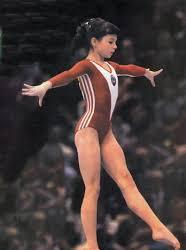
A Gymnastics Mystery: Was the 1981 World Championship Stolen? Part 2 - A Nearly Perfect Year
In our last episode I introduced one of the greatest mysteries in gymnastics history. Did the East German government ask Maxi Gnauck to fake an injury thus taking herself out of the 1981 All Around World Championship which was held in Moscow and won in a podium sweep by the Soviet Union. To understand why this is even a question we first have to examine the 1981 elite season (and some of the insanity that happened during it).
The previous year the 1980 Olympics was an unseemly mess where the Romanian vice president of the Women’s Technical Committee held up the All Around for almost half an half an hour trying to get Nadia Comăneci beam score raised so that she could win her second Olympic AA. When she couldn’t convince the judges and technical officials to raise the score she simply refused to the score into the computer. Meanwhile on the sidelines Bela Karolyi was screaming about corruption and unfair scoring against his gymnasts including Emilia Eberle in the uneven bars final. The winner of that final was 16 year old East German Maxi Gnauck and she also had to share the AA silver with Nadia.
If the drama and ill spirited corruption was at unprecedented levels during the 1980 Olympics, things just got worse (and stranger) at the beginning of 1981. In January 1981 the Romanian gymnastics team, coached by Bela Karolyi, visited the United States to attend an invitational competition where their headliner was to be Ekaterina Szabo, the reigning junior European Champion. Except the girl carrying Szabo’s passport wasn’t Ekaterina Szabo but Levinia Agache (another future Olympic gold medalist).
youtube
We’ll never know why the Romanians did this. Some people have suggested the meet organizers were aware of the deception though Kathy Johnson on twitter strongly denied that, saying the only reason anyone knew something was wrong was because an American gymnast in the crowd had seen Szabo at a previous meet and alerted officials. But as the passport was issued by the Romanian government and they had no more proof of the impersonation the matter was dropped for the time. Two months later the Romanians would return to the United States this time with the real Ekaterina Szabo and Levinia Agache carrying her own passport. Because.... why... anyway it was on this trip that Bela Karolyi and his wife Marta would defect.
A few months later the first major gymnastics meet of the year the European Championships was held in velodrome in Madrid. [As an aside, for some reason velodromes were very popular for hosting gymnastics meets in the 1980s, not only the 1981 Euros, but the 1985 and 1987 World championships and I seem to recall at least one other Euros that decade were held in velodromes.] At this meet the USSR did not send Olympic AA gold medalist Elena Davydova, but instead 3 rising talents Alla Misnik, Natalia Ilienko, and a “new senior” age falsified Olga Bicherova. It’s important to remember that in an age when the sport was dominated by European gymnasts the European championships was a bellwether for the winners of world and olympic competitions. Nadia Comăneci announced herself to the world, not at the American Cup as the American gymnastics federation liked to say, but rather at the European Championships before the Montreal Olympic Games. It can be assumed that the Soviets wanted to use the event to introduce their new stars to the world.
The only problem with that plan was Maxi Gnauck turned that Spanish velodrome into her personal stage to demonstrate her dominance. She won the AA by .3 over Romanian Cristina Grigoras, with Misnik and Ilienko come in 3rd and 4th. Bicherova had a disaster of a meet and came in 23rd. Gnauck also took 3 of the 4 event gold medals, having to settle for “only” a silver on vault. Now one of the great things about 1981 Euros is that we have incredibly high quality film of the event (without commentary so you can hear how incredibly loud it was whenever anyone landed a vault or a beam dismount). it’s worth looking at those event finals to see what kind of shape Gnauck was in.
Let’s start with vault, the only gold medal that Gnauck did not win...
youtube
Skip to 13.37 for Gnauck’s vaults, if you want to watch the entire final I suggest you skip ahead in the video as it includes both the beginning sound test and the full warm up period. The things I want you to see here are just how much power she had coming down the runway and how good her form was. Remember this was an age before Yurchenko entries where gymnasts had to get all their power from a handspring block. Gnauck would tie for silver with her countrywoman the amazingly named Birgit Senff.
It’s as good as any time to talk a little bit about ties in 1970s and 1980s gymnastics because they can be an indication of corruption in that a rightful winner wouldn’t be denied outright but would have to share their win with the favored gymnast. But generally I think modern viewers just don’t realize how easy it was to tie when scores could only be given in increments of .1 and there were only 4 judges two of whose scores were dropped. There were only so many possible scores and so you were simply mathematically more likely to tie before the judging panel was expanded and deductions could be given in increments of .05. It also helped that no one seemed particularly interested in breaking ties.
youtube
After that “disappointing” silver we move onto Gnauck’s stroll through dominating the entire European field. Skip to 20.08 for her bars routine. As with her 1980 bars I’d like you to look at how good her form is, and let me repeat again this bars set was so consistent that you could essentially pick any competition between 1979 and 1984 and see the same thing from her.
youtube
Next came the balance beam. Start at 19.21 for Gnauck. Now Maxi is not the kind of beamer that you will want to write poetry about, and she has two significant balance checks here. She barely won this title by .1, a margin she carried over from the AA (a routine you can see here at timestamp 2.01.31). I urge you to look at the AA beam performance without the balance checks to understand just the high level of beam tumbling difficulty Gnauck had in 1981.
At this point you may be wondering about the socks/ankle taping, since the question of the injury at worlds was her ankle. But this kind of extreme ankle taping was not just common but basically universal among East German gymnasts. It’s not evidence of an injury. There is a reason I will sometimes describe a heavy ankle tape job as “being taped like an East German”. But hey if you are doing that level of beam difficulty and landing on those cardboard mats I think you might proactively tape your ankles too...
youtube
And then we come to the floor final which she wins by .2, not entirely by her carry over score (she did better in the final relative to the silver medalist and lost ground relative to the bronze medalist). The European Championships was an optionals only competition (the AA acted as qualification for EF and the scores carried over) so you couldn’t hide score fixing in compulsories like you could at the World Championship. You can find Gnauck’s routine at 7.00 minutes into the video (the floor silver medalist Alla Minsk of the USSR is at 10.40, and the floor bronze medalist Cristina Grigoras of Romania is at 31.39). I think you can understand the placing simply based on landings and tumbling difficulty.
Normally this is the point when I talk about East Germans that I have to try and make an excuse for their weird floor music and chorographical choices. Gnauck has her share of them and I wouldn’t call her balletic. But she is performing, clearly has dance training, and I think if you look at her and think about any “power gymnast” of the modern era you can understand her. As it happens at this competition I don’t feel the need to defend her choreography given that the Soviets were in their disco period and the Romanians were still using Geza Pozsar choreography (he had defected only weeks before).
I think there are arguments to be had about Eastern Bloc leotard bonuses at Worlds (and I think in particular Ma Yanhong had legitimate grievances over it), but the thing I want to emphasize here is that the people Gnauck was beating here weren’t the Chinese or the western Europeans or the Americans. She was beating the Soviets and the Romanians. Even if the East Germans were overscored they weren’t being overscored over the Soviets or the Romanians.
Gnauck came out of the 1981 European Championships with 4 gold medals, and 1 silver medal. She had come away from the 1980 Olympics with 4 medals as well as a 4th in the Balance Beam final that Nadia won IMO on reputation (only .1 of a point covered 1-4 in the 1980 Olympic Balance Beam final).
Coming into Moscow there would have been no question that she was the prohibitive favorite to win the World All Around.
Next time: The world’s most comically corrupt elite gymnastics meet and the strange events of the 1981 World Championships.
4 notes
·
View notes
Photo
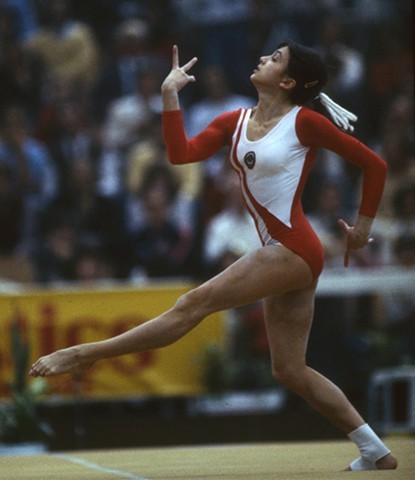
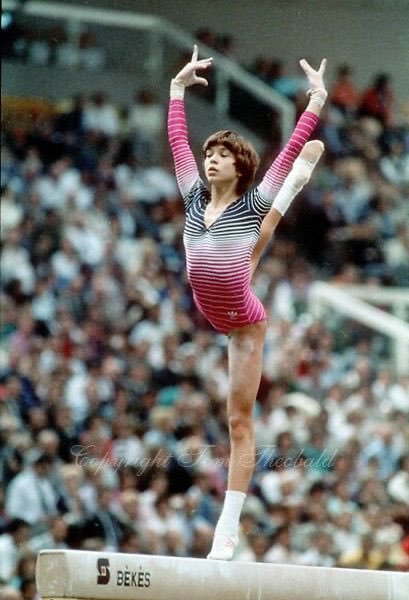

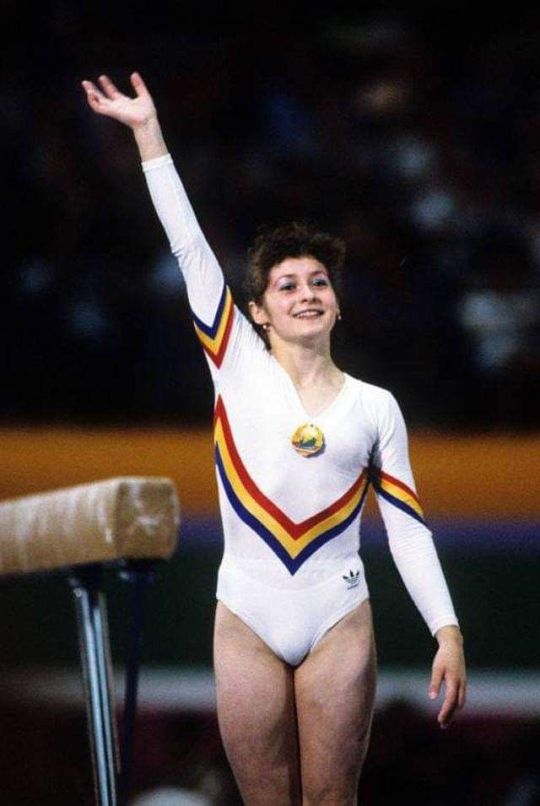
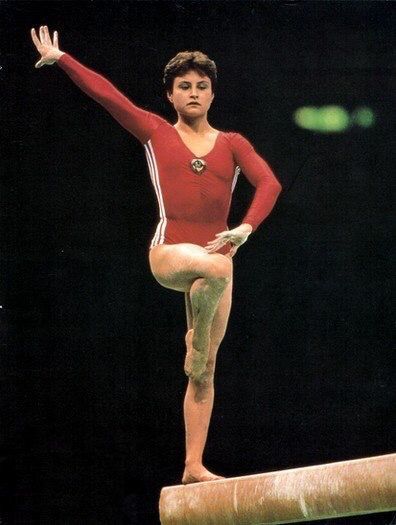
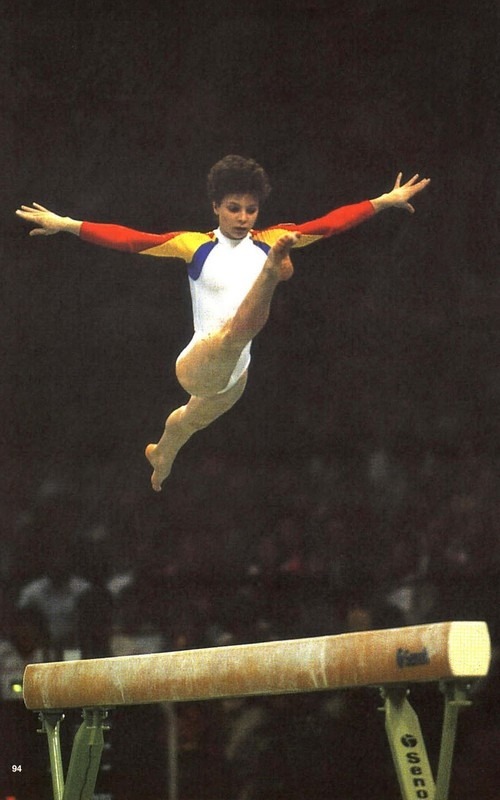
A History of Gymnastics as I would tell it: Part 2 Mold Breakers
I think you start the 1980s as a narrative about Soviet dominance. Maybe show medal podium at the 1981 World Championships AA and a discussion of the relentless push of the Soviet machine. Maybe even present just how hard it was to stay at the top in Soviet gymnastics with Davydova yielding to Bicherova who then had Yurcheno and Mostaponova at her heels. Contrast that with the rivals not being able to burn through athletes quite so fast. Maxi Gnauck’s relatively long career in this period and her level of consistent domination work well. But perhaps you also use this moment to tell the story of Gabriele Fähnrich and how a brief conversation about a broken camera with a West German athlete lead to her being harassed by the secret police.
I would then move onto Yurchenko and the story of how that vault revolutionized the event but also raised questions about safety and a sport that had risk explicitly as one of it’s values. It was one thing when risk contemplated you would gracelessly fall off a balance beam. It was another thing when it asked you to perhaps break your neck on the vault.
I think you then talk about 1984 and in my ideal world you make this as a contrast between the style of Mary Lou Retton in the bright lights and fame of LA and the fragments of black and white footage we have of Olga Mostapanova’s perfect 40 at the Friendship Games. Maybe even take this moment to talk about the impacts of both boycotts on the public fame of the athletes from 1980 and 1984.
I think I would then pick up Szabo as a character... the woman who won more golds at Los Angeles but was seen as second place and how she then had to face challengers who raised the stakes of tumbling difficulty. I think this is when you introduce Elena Shushunova and tumbling passes that scared other competitors.
This would build to me in the aftermath of 1987 Worlds. The shock of the Romanians taking both the team and the all around and how that invoked the Soviets to work that much harder to be that much better in 1988. That would be a good set up for Silivas and Shushunova in Korea as a relentless drive for perfection as they matched each other score for score.
3 notes
·
View notes
Photo

Cheating isn’t just about score rigging in 1980s gymnastics.
I present to you the 1982 World Cup.
Now over the course of gymnastics history the World Cup has had a bunch of formats. In 1982 the top gymnasts from the previous years world championships (AA and event medalists) were invited to compete in a competition which had both an All Around and Event Finals. If a country had an injury to one of those gymnasts they could substitute using someone who had "participated” at the world championships. The idea was to have a competition of only the best gymnasts in the world and in general in this period I find the World Cup to be some of the most interesting gymnastics.
The United States had one of it’s 1981 World Championship medalists injured and they petitioned to replace her with Diane Durham who was one of the rising stars of American gymnastics at the time. That petition was denied on the basis that Durham hadn’t competed in the 1981 World Championships. When they arrived at the competition in Yugoslovia they discovered that the Soviet Union had sent Natalia Yurchenko who while an excellent gymnast in 1982 hadn’t participated in the 1981 world championships. When the US protested to the FIG the FIG president (who was also president of the Soviet gymnastics federation) said that Yurchenko had been a reserve at the 1979 world championships.
The rules didn’t specify how far back you could go and the United States’ Jackie Fie pointed out that if you could go back past both a world championships and an Olympic games that she could have put on a leotard and competed for the United States that day (having participated in a world championships in the 1950s). There was also a question of if Yurchenko was even an alternate in 1979 at all because there were no records other than taking the Soviet’s word. Which if they were cheating here, which they probably were, the answer is likely that there would be records of alternates to the Olympic Games accessible outside of the Soviet Union.
And all of this is in addition to the fact that Olga Bicherova, the 1981 All Around World Champion had her age falsified in 1981 to say she was 15. It is to this day not clear how old Bicherova was in 1981. 12 or 13 seem to be the most reasonable guesses. Even if she might have been 14 in 1982 she was still not of age for the qualifying competition in 1981.
3 notes
·
View notes
